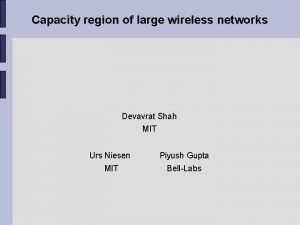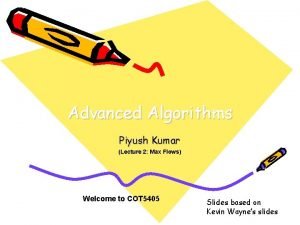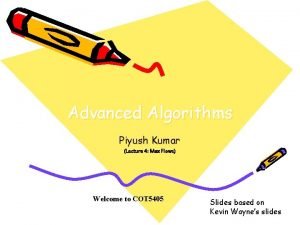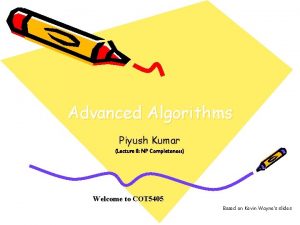Advanced Algorithms Piyush Kumar Lecture 5 Preflow Push
























- Slides: 24

Advanced Algorithms Piyush Kumar (Lecture 5: Preflow Push) Welcome to COT 5405

Today • Preflow Push

Review: Augmenting Path • Maintains a flow in each iteration • Finds a path in the residual graph • Saturates the path to make progress.

Flows • Def. An s-t flow is a function that satisfies: – For each e E: (capacity) – For each v V – {s, t}: (conservation) • Def. The value of a flow f is: 0 2 4 10 4 4 0 5 s 9 0 15 5 0 15 0 4 4 3 8 6 0 capacity 15 flow 0 4 0 6 15 0 0 4 30 10 7 10 t 0 10 Value = 4

A Preflow • Def. An preflow is a function that satisfies: – For each e E: (capacity) – For each v V – {s, t}: (weak conservation) • Def. The excess of a preflow f at node v : – Required to be non-negative except s, t 1. 2. 3. 4. Algorithm maintains preflow (not flow) Each vertex is associated with a height Flow is “downhill” Vertices with excess are sometimes “lifted/relabeled”.

A Preflow Total excess = flow out of s - flow into t 1 7/10 Nodes with +ve Excess are called Active s 5/5 G: 10/10 2/2 2 e=9 3/3 t

Labelling/Height function • H: V -> N – Source and Sink condition • h(s) = n • h(t) = 0 Invariant – Steepness condition • For all (v, w) in Ef , h(v) <= h(w)+1 • Here Ef is the residual graph. Compatibility of preflows and labellings

Lemma • If s-t preflow f is compatible with the labelling h, then there is no s-t path in the residual graph Gf. • Cor: If s-t flow f is compatible with a labelling h, then f is a flow of maximum value.

Initial Preflow f • • h(v) = 0 for all v <> s h(s) = n f(e) = ce for all e=(s, v) f(e) = 0 for all other edges. The algorithm gradually transforms a preflow to a flow. Why?

Lemma • An s-t preflow f is compatible with a labelling h, then there is no s-t path in the residual graph Gf. • Cor: An s-t flow f is maximum when its compatible with labelling h.

s G: e=10 10/10 1 Preflow-Push Algorithm Initialization example 10/10 2 2 e=10 5 3 t s Gf: 10 10 1 2 2 5 3 t

Basic Operation 1 Push forward edge • Suppose e(u)>0, cf(u, v)>0, (u, v) in Ef (u, v) is a forward edge h[u]= h[v]+1 • Push as much flow across (u, v) as possible r = min (e[u], c(u, v) – f(e)) Increase f(e) by r.

Basic Operation 2 Push backward edge • Suppose e(u)>0, cf(u, v)>0, (u, v) in Ef (u, v) is a backward edge h[u]= h[v]+1 • Push as much flow across (u, v) as possible r = min (e[u], f(e)) Decrease f(e) by r. The preflow push algorithm will try to push from Active nodes towards the sink (maintaining compatibility with the labelling/heights of the nodes)

Basic Operation 3 Lift/Relabel • When no push can be done from overflowing vertex (except s, t) • Suppose e[u]>0, and for all (u, v) in Ef : h[u] £ h[v], u ¹ s, u ¹ t – Set h[u] = h[u] + 1

Preflow-Push • Initialize • While there is a node v <> t with ef(v) > 0 E – If w such that push (f, h, v, w) is possible • Push(f, h, v, w) – Else • Relabel(f, h, v)

Preflow push demo

Invariants 1. The labels are >= 0 and integers 2. f is a preflow, if the capacities are integral, the preflows are integral. 3. The preflow f and labelling h are compatible. 4. The height of a node never decreases.

Lemma • Lef f be a preflow. If excessf(v) > 0 then there is a path in Gf from v to source s. • Pf: Let A denote all the nodes that have a path to s in Gf. B = V A. What happens to edges inside B? If e has only its head in B? If e has only its tail in B? –fout(B)

Lemmas • The height of a node is upper bounded by 2 n-1. • Cor: Each node is relabeled at most 2 n-1 times, hence total relabels is upper bounded by 2 n 2

Lemma: Saturating Pushes • Throughout the algorithm, the number of saturating push operations is at most 2 mn. • Pf: Look at a saturating push along an edge. When can another saturating push happen thru the same edge? (If it needs lifting, how many lifts can one do on such a node in total? )

Potential function arguments • Consider a joint bank account held by A, B, and C • The account starts with an initial deposit of at most n 2. – A only makes withdrawals, each for 1 or more. – B makes fewer than n 2 deposits. Each deposit is for at most 1. – C makes fewer than nm withdrawals and deposits. Each deposit is for at most n. – The account never goes below 0. • What is the maximum number of withdrawals for A?

Lemma: Non-Saturating Pushes Potential Functions Argument • Lemma: The number of non-saturating push operations is bounded by 4 mn 2 • Pf: Define: A non saturating push decreases it by at least 1. A saturating push increases it by at most 2 n-1 A relabel increases it by exactly 1. If we pick the active node at maximum height For pushing, we can get O(n^3) non-sat. pushes.

Modifications • A simple modification gives O(n 3). • Theorem: The total running time of the algorithm is upper bounded by O(mn 2)

References • R. K. Ahuja, T. L. Magnanti, and J. B. Orlin. Network Flows. Prentice Hall, 1993. (Reserved in Dirac) • K. Mehlhorn and S. Naeher. The LEDA Platform for Combinatorial and Geometric Computing. Cambridge University Press, 1999. 1018 pages
 Preflow push algorithm
Preflow push algorithm Dr piyush jain rml hospital
Dr piyush jain rml hospital Piyush gupta mit
Piyush gupta mit Molten weld pool
Molten weld pool Pulseless electrical activity
Pulseless electrical activity Push hard push fast fully recoil
Push hard push fast fully recoil Capnoea
Capnoea Push hard push fast fully recoil
Push hard push fast fully recoil Asp medical
Asp medical Push hard push fast fully recoil
Push hard push fast fully recoil Introduction to algorithms lecture notes
Introduction to algorithms lecture notes Analysis of algorithms lecture notes
Analysis of algorithms lecture notes Interpolation search formula
Interpolation search formula 01:640:244 lecture notes - lecture 15: plat, idah, farad
01:640:244 lecture notes - lecture 15: plat, idah, farad Advanced inorganic chemistry lecture notes
Advanced inorganic chemistry lecture notes Kumar n. sivarajan
Kumar n. sivarajan Amit kumar microsoft
Amit kumar microsoft Dr. pradip kumar khastagir
Dr. pradip kumar khastagir Saturn
Saturn Rakesh kumar uiuc
Rakesh kumar uiuc Nirupama prakash kumar
Nirupama prakash kumar Association analysis advanced concepts
Association analysis advanced concepts Mohak sukhwani
Mohak sukhwani Chetan prakash vs met institute
Chetan prakash vs met institute Cholegogue
Cholegogue














































